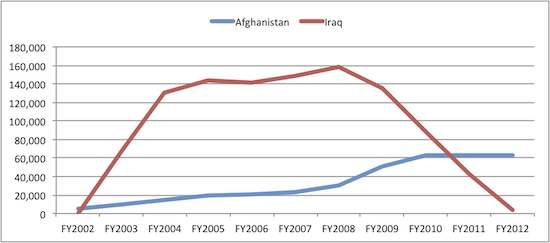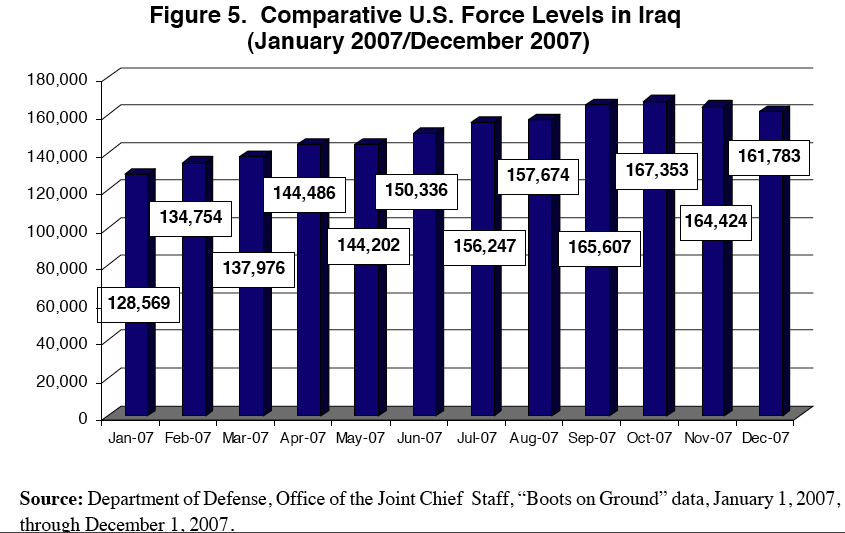I’ve just finished reading Obama Wars by Bob Woodward which centered around the Obama administration’s decision to add troops to Afghanistan. It made me curious how troop strength had ebbed and flowed through the last ten years of war.
A quick search on the internet found a 72 page paper prepared for the Congressional Research Service, Troop Levels in the Afghan and Iraq Wars, FY2001-FY2012: Cost and Other Potential Issues by Amy Belasco. This paper provides an analysis of troop strength in Iraq and Afghanistan and the costs associated with those troups.
Below is a table and graph of “boots on the ground” as measured through 2009 and estimated through 2012. Though the announced strategy is to begin drawing down troops in Afghanistan this July, the paper doesn’t project any reduction this or next year. The report also notes that…
“Although Boots on the Ground is the most commonly cited measure of troop strength, that measure does not include over 100,000 other troops deployed in the region providing theater- wide support for Operation Enduring Freedom (OEF), the Afghan War, and Operation Iraqi Freedom (OIF), the Iraq War.”
| Average Monthly Boots On the Ground in Afghanistan and Iraq: FY2002-FY2012 Reported FY02-FY08, Estimated FY09-FY12, Rounded to Hundreds |
||||||
| Percentage Change | ||||||
|---|---|---|---|---|---|---|
| Fiscal Year/Country |
Afghanistan | Iraq | Total | Annual | Since FY2003 |
Since FY2008 |
| FY2002 | 5,200 | 0 | 5,200 | NA | NA | NA |
| FY2003 | 10,400 | 67,700 | 78,100 | 1402% | NA | NA |
| FY2004 | 15,200 | 130,600 | 145,800 | 87% | 87% | NA |
| FY2005 | 19,100 | 143,800 | 162,900 | 12% | 109% | NA |
| FY2006 | 20,400 | 141,100 | 161,500 | -1% | 107% | NA |
| FY2007 | 23,700 | 148,300 | 172,000 | 7% | 120% | NA |
| FY2008 | 30,100 | 157,800 | 187,900 | 9% | 141% | NA |
| FY2009 | 50,700 | 135,600 | 186,300 | -1% | 139% | -1% |
| FY2010 | 63,500 | 88,300 | 151,800 | -19% | 94% | -19% |
| FY2011 | 63,500 | 42,800 | 106,200 | -30% | 36% | -43% |
| FY2012 | 63,500 | 4,100 | 67,500 | -36% | -14% | -64% |
 |
||||||
| A Belasco. (2009, July 2). Troop Levels in the Afghan and Iraq Wars, FY2001-FY2012: Cost and Other Potential Issues [pdf]. Available: http://www.fas.org/sgp/crs/natsec/ | ||||||

